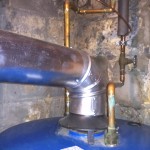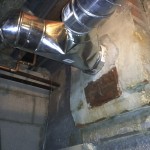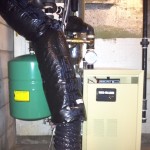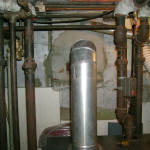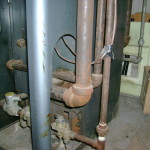I have the old furnace and old boiler systems. How can I tell if they are still safe to use this winter?
Oct 21 2013 · 0 comments · Heating, Safety- A hot water tank using natural draft vent to exhaust combustion.
- A chimney clean out and Y connection to the chimney.
- A modern hot water boiler furnace.
- Vent for old furnance.
- Chimney before the upgrade.
- Old boiler furnace, view of pilot light and safety vales.
By the term ‘old’ we are referring to the natural draft appliances that burn natural gas or propane. These include furnaces and boilers that recently, TSSA has determined may result in carbon monoxide (CO) safety hazard in the home and may cause personal injury and even result in death.
The safe use of fuels used to heat our homes in Ontario falls under the Technical Standards and Safety Act, 2000. The Technical Standards and Safety Authority (TSSA) is designated by Ontario’s Ministry of Consumer Services to administer and enforce this Act.
CO is a colorless, odorless and tasteless gas produced when fuels such as natural gas and propane are incompletely burned. Common causes include poor maintenance of the appliance leading to incomplete combustion of the fuel and depressurization of the house causing back draft conditions in the house. The depressurization of the home is caused by other exhaust systems that prevent the natural draft to work properly. Other exhaust systems include dryer exhaust, kitchen or bathroom exhaust and wood fire place. Also, the upgrades to more efficient windows and doors limit the outside air infiltration into the home creating a ‘tighter’ environment.
The symptoms of CO poisoning include vomiting and nausea, burning eyes and dizziness, difficulty breathing, confusion and victims may also become unconscious. If CO is undetected in the home, occupants have been found dead in their sleep.
So how can you tell if the appliances are safe to use? Get them checked and maintained on an annual basis by a licensed gas technician. They will perform a CO safety check during the maintenance visit. Install CO detector in the house. The ideal location of it is not in the furnace room or anywhere near it. You want it working ideally on the second floor hall way so that there is early warning when CO is detected instead of waiting of it to travel from one room to the next if you installed it in one of the bedrooms.
For more information visit www.tssa.org

